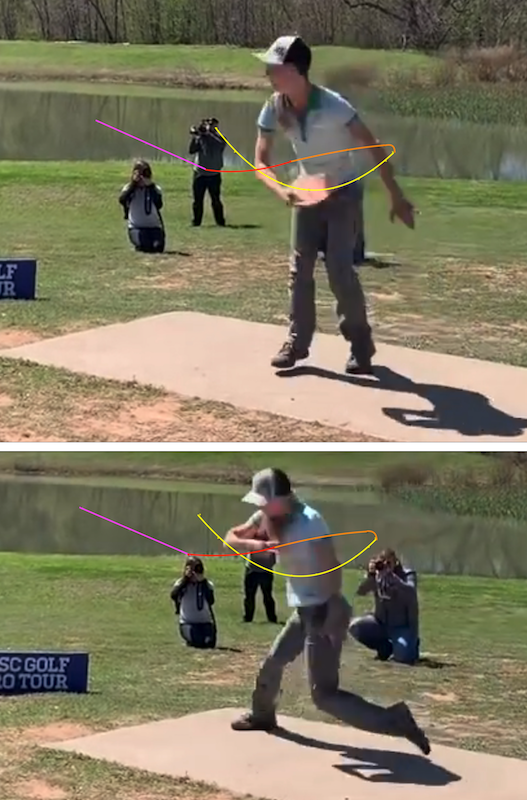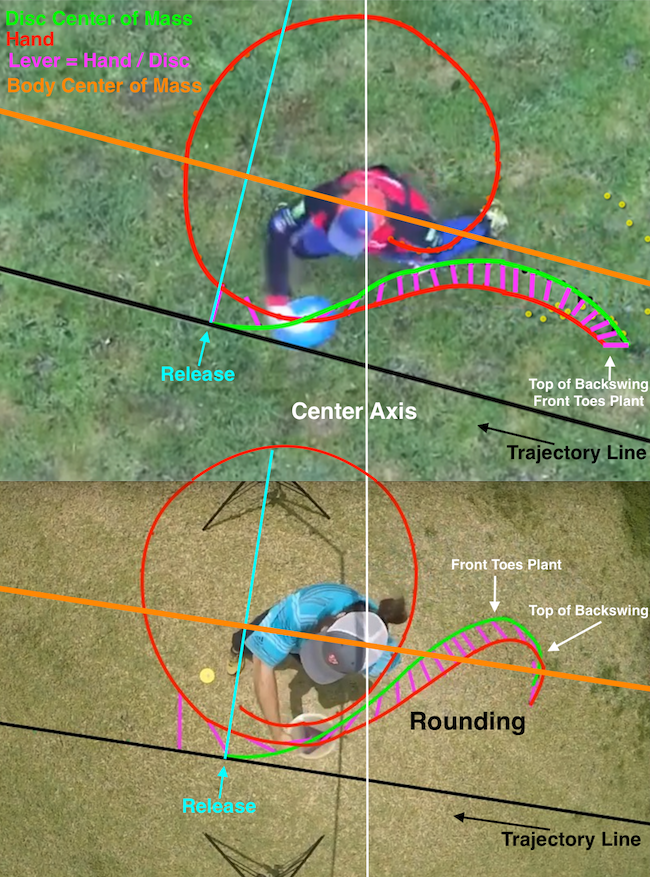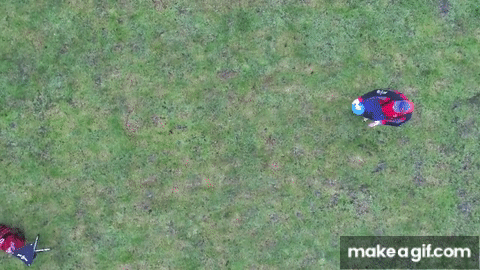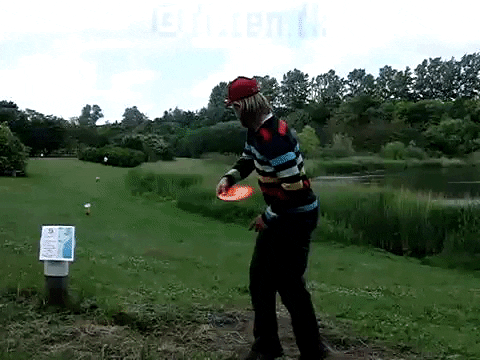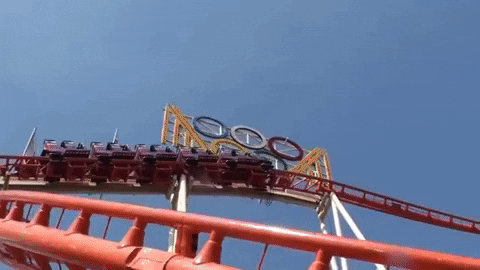FulaFirren
Bogey Member
- Joined
- Nov 16, 2020
- Messages
- 50
As the title suggests I think that there are two different overarching styles in pro form, and I think one is far superior to the other. The easiest way is probably just to show different throws using the different techniques, but my "short" summary is this (videos after):
Whip:
There is no reachback, it's more like a backwards extension, from a bent elbow to a straight elbow. The left arm controls the whip, with the right arm going from bent, to extended to bent to extended. The rhythm is "in->out-in-out", where you start with the disc close to your body with a bent elbow ("in") then it goes "out-in-out" quickly. In my head it's "right-left-right" because I consiously extend the right arm (but only momentarily), then I completely relax it while extending the left arm and pushing the left shoulder forward. This brings the right arm into the pocket (which doesn't collapse/cause rounding because you shrug the right shoulder forward and internally rotate it). Then you fully activate the right arm for the swing/outward arc (while the left arm continues backwards "stopping" the left shoulder/pulling the handle of the whip back. This is known as the "swim move", check Drew Gibson gif below). I use the word swing for the last part of the whip because it sort of is a swing although it's only at the final part of the motion compared to what I define the "Swing technique" as.
The momentary backward extension is what Simon Lizotte describes as the "slingshot reachback" (the Anthony Barela gif below shows this clearly). Also realize that the disc will not stay on the same plane throughout the whip. You need to shrug + internally rotate your right shoulder in order to not collapse the pocket, and this will bring the disc off the plane relative to the ground, but this is irrelevant for the release angle. Look at this picture of Simon for example. He is about to throw a hyzer with barely any OAT at all, and this disc is literally 90 degrees "off plane":

Every whipper does this, although some have a less pronounced motion.
Sidenote: I also like to time the right arm backward extension by sort of moving my left hand in in front of my stomach with a bent elbow, then bringing it down and then it naturally transitions into the swim move. Jordan Castro, Drew Gibson and Paige Pierce do this as well, and Mcbeth kind of does it. Pay attention to the Drew Gibson gif below. It's like an actual breast stroke and I think it's very helpful for timing the whole thing.
Swing:
Again there is no reachback, but the arm is kept bent and the whole body coils and then swings forward. As a consequence of the bent arm the disc will come higher at peak coil, but it's not really important on its own. Basically you're getting to the same swing/outward arc point as in the whip technique, but you're losing the whip redirection of the disc that I think builds up additional lag and better momentum transfer.
Whippers:
Anthony Barela (one of the most pronounced whippers):
https://imgur.com/6cMEUSz
Jordan Castro (I actually love his backhand, insanely effortless):
https://imgur.com/d0Jtlrv
Drew Gibson:
https://imgur.com/2PZ8GU1
Other whippers:
McBeth, Eagle McMahon, Simon Lizotte, Will Schusterick, and obviously David Wiggins Jr.
Swingers :
:
James Conrad:
https://imgur.com/kWioTWC
Emerson Keith:
https://imgur.com/zVt7qdI
Scott Stokely (a little bit ironic as he teaches the "straight pull", which if anything more resembles the whip technique):
https://imgur.com/a/psnNPHp
I think it is a lot easier to control release direction with the whip technique, as long as you trust it. This is how you achieve truly effortless power. Yes you can make the pure swing work, but it's not effortless in the same way (look at James Conrad or Emerson Keith and compare it to Castro or Eagle in the video below). Now both require timing, and you can clearly get good distance with the swing as well. It's just not as effortless and thus harder to control imo. Also I feel like it's much harder to get a good anhyzer swing without completely shanking it over, while if you snap the whip you can just snap it on that angle. But that could just be my personal feeling and I suppose Conrad proves me wrong big time on that one.
I think just watching the Jordan Castro gif over and over watching for different things and feeling the timing of the whip, paying particular attention to his left arm action, could make it click for somone. He has a really clean effortless whip, with a left arm "swim move" like Gibson, out-in-out motion (where you can also notice how the disc gets about 90 degrees "off plane" as well). Keep in mind it's a touch shot so the initial "out" is not as aggressive/fast. Unfortunately in that particular shot he lined the whole thing up in the wrong direction..
You could also try looking at the whippers and think "right-left-right" (arm), trying to feel the rhythm.
Whip:
There is no reachback, it's more like a backwards extension, from a bent elbow to a straight elbow. The left arm controls the whip, with the right arm going from bent, to extended to bent to extended. The rhythm is "in->out-in-out", where you start with the disc close to your body with a bent elbow ("in") then it goes "out-in-out" quickly. In my head it's "right-left-right" because I consiously extend the right arm (but only momentarily), then I completely relax it while extending the left arm and pushing the left shoulder forward. This brings the right arm into the pocket (which doesn't collapse/cause rounding because you shrug the right shoulder forward and internally rotate it). Then you fully activate the right arm for the swing/outward arc (while the left arm continues backwards "stopping" the left shoulder/pulling the handle of the whip back. This is known as the "swim move", check Drew Gibson gif below). I use the word swing for the last part of the whip because it sort of is a swing although it's only at the final part of the motion compared to what I define the "Swing technique" as.
The momentary backward extension is what Simon Lizotte describes as the "slingshot reachback" (the Anthony Barela gif below shows this clearly). Also realize that the disc will not stay on the same plane throughout the whip. You need to shrug + internally rotate your right shoulder in order to not collapse the pocket, and this will bring the disc off the plane relative to the ground, but this is irrelevant for the release angle. Look at this picture of Simon for example. He is about to throw a hyzer with barely any OAT at all, and this disc is literally 90 degrees "off plane":
Every whipper does this, although some have a less pronounced motion.
Sidenote: I also like to time the right arm backward extension by sort of moving my left hand in in front of my stomach with a bent elbow, then bringing it down and then it naturally transitions into the swim move. Jordan Castro, Drew Gibson and Paige Pierce do this as well, and Mcbeth kind of does it. Pay attention to the Drew Gibson gif below. It's like an actual breast stroke and I think it's very helpful for timing the whole thing.
Swing:
Again there is no reachback, but the arm is kept bent and the whole body coils and then swings forward. As a consequence of the bent arm the disc will come higher at peak coil, but it's not really important on its own. Basically you're getting to the same swing/outward arc point as in the whip technique, but you're losing the whip redirection of the disc that I think builds up additional lag and better momentum transfer.
Whippers:
Anthony Barela (one of the most pronounced whippers):
https://imgur.com/6cMEUSz
Jordan Castro (I actually love his backhand, insanely effortless):
https://imgur.com/d0Jtlrv
Drew Gibson:
https://imgur.com/2PZ8GU1
Other whippers:
McBeth, Eagle McMahon, Simon Lizotte, Will Schusterick, and obviously David Wiggins Jr.
Swingers
James Conrad:
https://imgur.com/kWioTWC
Emerson Keith:
https://imgur.com/zVt7qdI
Scott Stokely (a little bit ironic as he teaches the "straight pull", which if anything more resembles the whip technique):
https://imgur.com/a/psnNPHp
I think it is a lot easier to control release direction with the whip technique, as long as you trust it. This is how you achieve truly effortless power. Yes you can make the pure swing work, but it's not effortless in the same way (look at James Conrad or Emerson Keith and compare it to Castro or Eagle in the video below). Now both require timing, and you can clearly get good distance with the swing as well. It's just not as effortless and thus harder to control imo. Also I feel like it's much harder to get a good anhyzer swing without completely shanking it over, while if you snap the whip you can just snap it on that angle. But that could just be my personal feeling and I suppose Conrad proves me wrong big time on that one.
I think just watching the Jordan Castro gif over and over watching for different things and feeling the timing of the whip, paying particular attention to his left arm action, could make it click for somone. He has a really clean effortless whip, with a left arm "swim move" like Gibson, out-in-out motion (where you can also notice how the disc gets about 90 degrees "off plane" as well). Keep in mind it's a touch shot so the initial "out" is not as aggressive/fast. Unfortunately in that particular shot he lined the whole thing up in the wrong direction..
You could also try looking at the whippers and think "right-left-right" (arm), trying to feel the rhythm.
Last edited:
